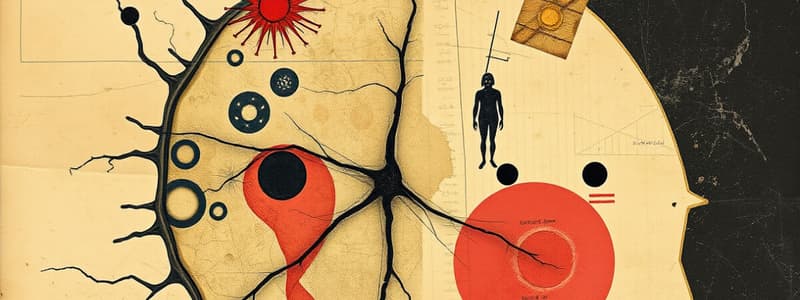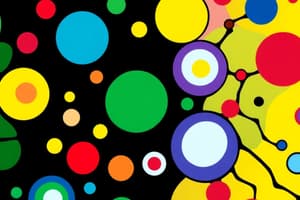Podcast
Questions and Answers
Who concluded that all plant parts are made of cells?
Who concluded that all plant parts are made of cells?
- William Harvey
- Matthias Schleiden (correct)
- Rudolf Virchow
- Theodor Schwann
Cell theory states that all living things are made of cells and they arise from non-living matter.
Cell theory states that all living things are made of cells and they arise from non-living matter.
False (B)
Who is known as the 'Father of Modern Anatomy'?
Who is known as the 'Father of Modern Anatomy'?
Andreas Vesalius
The Greek physician _____ described the anatomy of the human body based on dissection.
The Greek physician _____ described the anatomy of the human body based on dissection.
Match the following scientists with their contributions:
Match the following scientists with their contributions:
Which scientist demonstrated that arteries carry blood?
Which scientist demonstrated that arteries carry blood?
Theodor Schwann was a close friend of Matthias Schleiden and stated that all animal tissues are made of cells.
Theodor Schwann was a close friend of Matthias Schleiden and stated that all animal tissues are made of cells.
_____ proved the principle that structure and function must be studied together.
_____ proved the principle that structure and function must be studied together.
What is Anton van Leeuwenhoek best known for?
What is Anton van Leeuwenhoek best known for?
Carl Linnaeus developed the theory of evolution.
Carl Linnaeus developed the theory of evolution.
What are the seven pairs of characteristics studied by Gregor Mendel in his experiments with pea plants?
What are the seven pairs of characteristics studied by Gregor Mendel in his experiments with pea plants?
The Theory of __________ was presented in Darwin's book 'Origin of Species'.
The Theory of __________ was presented in Darwin's book 'Origin of Species'.
Which scientists are credited with elucidating the double helix structure of DNA?
Which scientists are credited with elucidating the double helix structure of DNA?
James Watson and Francis Crick were the first to discover DNA.
James Watson and Francis Crick were the first to discover DNA.
Who is known as the Father of Cell Biology?
Who is known as the Father of Cell Biology?
Match the scientist with their respective contribution:
Match the scientist with their respective contribution:
What type of sciences rely on quantitative data and are related to physical phenomena?
What type of sciences rely on quantitative data and are related to physical phenomena?
Basic science is focused on immediate applications and practical solutions.
Basic science is focused on immediate applications and practical solutions.
What are the two types of science mentioned?
What are the two types of science mentioned?
Natural sciences are sometimes referred to as _____ science.
Natural sciences are sometimes referred to as _____ science.
Match the scientific fields with their descriptions:
Match the scientific fields with their descriptions:
Which characteristic is NOT associated with living organisms?
Which characteristic is NOT associated with living organisms?
Applied science aims to solve real-world problems using scientific knowledge.
Applied science aims to solve real-world problems using scientific knowledge.
_____ is the property that describes an organism's ability to respond to environmental changes.
_____ is the property that describes an organism's ability to respond to environmental changes.
What is the term for the movement of an organism toward a chemical stimulus?
What is the term for the movement of an organism toward a chemical stimulus?
Adaptations in organisms are constant and do not change over time.
Adaptations in organisms are constant and do not change over time.
What is the role of DNA in reproduction?
What is the role of DNA in reproduction?
Plants can bend toward a source of _____ in a response to stimuli.
Plants can bend toward a source of _____ in a response to stimuli.
Match the following terms with their definitions:
Match the following terms with their definitions:
What is the advantage of multicellular organisms over single-celled organisms?
What is the advantage of multicellular organisms over single-celled organisms?
Movement away from a stimulus is considered a positive response.
Movement away from a stimulus is considered a positive response.
What directs the growth and development of an organism?
What directs the growth and development of an organism?
What does homeostasis refer to?
What does homeostasis refer to?
Homeostasis can only be achieved in the human body.
Homeostasis can only be achieved in the human body.
What is required for a California condor to fly?
What is required for a California condor to fly?
Polar bears maintain their body temperature by generating heat and reducing heat loss through thick _____ and a dense layer of fat.
Polar bears maintain their body temperature by generating heat and reducing heat loss through thick _____ and a dense layer of fat.
Match the following organisms to their related regulatory mechanism:
Match the following organisms to their related regulatory mechanism:
Why is a lot of energy needed for flight in California condors?
Why is a lot of energy needed for flight in California condors?
Energy from food is not necessary for any organisms to perform essential functions.
Energy from food is not necessary for any organisms to perform essential functions.
What internal conditions are maintained within a narrow range in organisms?
What internal conditions are maintained within a narrow range in organisms?
Flashcards are hidden until you start studying
Study Notes
Development of Cell Theory
- Matthias Schleiden (1838): All plant parts are composed of cells.
- Theodor Schwann (1839): All animal tissues are made up of cells.
- Rudolf Virchow (1858): Concluded that cells arise only from preexisting cells.
- Cell Theory:
- All living things consist of one or more cells.
- Cells are the basic units of structure and function in organisms.
- Cells originate only from existing cells.
Historical Figures in Biology
- Aristotle: Known as the "Father of Biology" and "Father of Zoology," he used systematic observation to study living organisms, contributing to taxonomy and animal behavior.
- Claudius Galen: Greek physician who studied human anatomy via dissections; errors in his findings were unchallenged for 1,300 years.
- Andreas Vesalius: The "Father of Modern Anatomy," he conducted detailed human anatomy studies and pioneered comparative anatomy methods.
- William Harvey: Demonstrated that the heart pumps blood, establishing the principles of circulation and integrating structure and function in anatomy.
- Anton van Leeuwenhoek: "Father of Microbiology" and "Father of Cell Biology," made pioneering discoveries in microscopic life with the advent of the microscope.
- Carolus Linnaeus: "Father of Taxonomy," developed the Binomial Nomenclature system for classifying and naming species, still in use today.
- Gregor Johann Mendel: "Father of Genetics," formulated the principles of heredity through studies on pea plant traits.
- Charles Darwin: His work in "Origin of Species" introduced the Theory of Evolution by Natural Selection, shaping modern biological thought.
Major Discoveries in Molecular Biology
- 1953: James Watson, Francis Crick, Maurice Wilkins, and Rosalind Franklin identified the double helix structure of DNA, crucial for understanding heredity.
Types of Science
- Natural Sciences: Includes fields like biology, chemistry, and physics, often referred to as "hard science" for their reliance on quantitative data.
- Basic Science: Focuses on knowledge expansion without immediate application, prioritizing pure understanding of phenomena.
- Applied Science: Uses scientific knowledge to address real-world problems, leading to practical applications.
Properties of Life
- All living organisms share key characteristics: Order, Sensitivity, Reproduction, Adaptation, Growth and Development, Regulation, Homeostasis, and Energy Processing.
Characteristics of Life
- Order: Highly organized structures made up of one or more cells; multicellular organisms benefit from specialized cell functions.
- Sensitivity: Organisms respond to environmental stimuli through mechanisms like chemotaxis (chemical response) and phototaxis (light response).
- Reproduction: Offspring inherit genetic material from parents, ensuring species continuity.
- Adaptation: Organisms fit to their environment via adaptations shaped by natural selection, which evolve over generations.
- Growth and Development: Organisms grow according to genetic instructions, ensuring young exhibit parental characteristics.
- Regulation: Organisms maintain complex internal mechanisms to coordinate functions and respond to external stresses.
- Homeostasis: Ability to maintain a stable internal environment despite external changes, such as temperature regulation in mammals.
- Energy Processing: Organisms utilize energy, often derived from food sources, for metabolic activities.
Studying That Suits You
Use AI to generate personalized quizzes and flashcards to suit your learning preferences.




